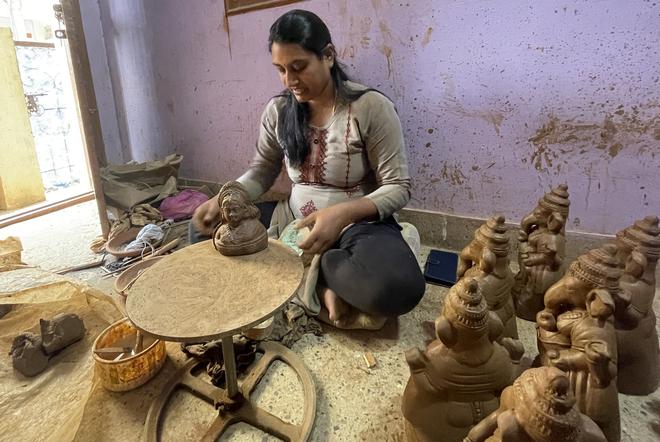As Ganesha Chaturthi, a festivity fondly known as Ganesha Habba in Karnataka, approaches, Pottery Town in Bengaluru is buzzing with activity. From mammoth 12-feet-tall, colourful idols lining the streets to small clay idols inside the homes of artisans, Pottery Town is teeming with Ganesha idols, and artisans are busy giving finishing touches to the works of art.
Pottery by Kumbara community (traditional potters) artisans in Bengaluru has been used in various cultural and religious ceremonies, besides for functional purposes over the centuries. However, with urbanization and the availability of mass-produced goods, traditional pottery-making has faced challenges. Many Kumbara artisans had to adapt to changing economic conditions. Some diversified their craft by producing more contemporary pottery to appeal to a bigger market, while many have quit their traditional vocation.

Dwindling numbers
Now, though there are close to 40 Kumbara community families at Pottery Town, the old settlement in Cantonment area in Bengaluru, only 15-20 families are actively practicing the traditional craft.
Hemanth Kumar, a sculptor and pottery instructor from Pottery Town, has been learning, practicing, and teaching pottery all his life. He, along with his aunt Anjanamma, makes different types of idols during the Ganesha Chaturthi season. While the family makes various styles of Ganesha idols -- like Mysuru Ganesha, Durbar Ganesha, Balmuri Ganesha, Kamala Ganesha, and so on -- what is special about this family’s craftmanship is the Ayyanar Ganesha, also known as Kai Ganesha (hand-made Ganesha on a potter’s lathe).
Not in a mould
“The Ayyanar Ganesha is made only on requests and is bought by few Tamil and Telugu communities. This idol is made of clay, by hand on the potter’s wheel and is not made using a mould like the other Ganesha idols we make. They do not have fancy decorations, and only a few features are painted with white, silver, and gold paint. These idols are expensive and are sold for around ₹4,000. Besides us, there is just one more family that makes the Ayyanar Ganesha, and it is found nowhere else in Bengaluru,” said Mr. Kumar.
Mr. Kumar, who pursued his education till Pre-University, decided to then take up his family’s traditional craft as his profession. However, Mr. Kumar did not restrict himself to just making idols but decided to learn pottery as a course at the Regional Design and Technical Research Centre. He now teaches pottery at various schools, corporate events and other gatherings.
Meanwhile, 63-year-old Anjanamma who taught Mr. Kumar and her children the skill of pottery, says the family does not want to force the tradition on their children. “Pottery has been our family business for 300 years now. My great-grandfather started it and now my children, their spouses and I have been practicing this art. My husband and his great-grandparents were born and brought up in Pottery Town and have practiced it all their lives too. I have grandchildren now and we have begun teaching them the basics of pottery. During festivities like Ganesha Habba and Deepavali, they help us out. However, they are too young to decide if they want to take up our tradition as a career. They are being educated, and it is left to them to decide their choice of career,” says Ms. Anjanamma.
Another artist in the locality, who does her business from her home and is also the first woman to take up the art of pottery in her family, is Geetha N.M., a sculptor and potter, and mother of two. Ms. Geetha, who learnt the art of idol making from her grandfather and father, makes hundreds of idols for Ganesha Chathurthi every year. Plain traditional Ganesha idols made of clay are once again popular, says Ms. Geetha
Clay idols in demand
“The traditional, colourless clay idol is a craft our family has been practicing for more than 100 years. As migrant potters from various states started coming in, for the last two decades, our skill was overshadowed with their idols that were made of plaster of Paris (PoP), painted and decked with stonework. However, people are now aware of the harm these idols cause to our environment and are trying to be more sustainable. Everyone is now switching to the simple idols we make, which is uplifting our skill and business,” she says.
Ms. Geetha says it is important to continue learning and building your skills no matter which profession you take up.
“I am the first woman from our family to take up the business after my father and grandfather. I grew up making Ganesha Idols right from my school days. But I realised that as someone from the Kumbara community, all I knew was to make Ganesha idols. Many non-Kumbaras were learning the art form passionately and creating beautiful art pieces. I wanted to upskill myself, so I joined a pottery course at the Regional Design and Technical Research Centre, where I learned to imagine and create more sculptures, and murals. I also learned about how to acquire loans, where to sell my products, and a lot more. Now I make terracotta jewellery, which is also exported and sold in the USA,” she says with pride.
She also makes chai or kulfi kullads (cups) which are in great demand from the food industry. She makes terracotta cutlery, toys, wall hangings, and puts up her stalls at various corporate events.







